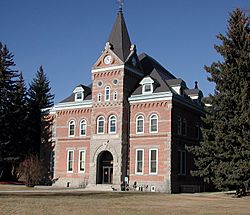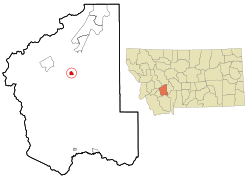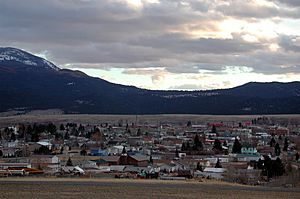Boulder, Montana facts for kids
Quick facts for kids
Boulder, Montana
|
||
|---|---|---|

Jefferson County Courthouse in Boulder
|
||
|
||

Location of Boulder, Montana
|
||
| Country | United States | |
| State | Montana | |
| County | Jefferson | |
| Area | ||
| • Town | 1.12 sq mi (2.91 km2) | |
| • Land | 1.12 sq mi (2.91 km2) | |
| • Water | 0.00 sq mi (0.00 km2) | |
| Elevation | 4,908 ft (1,496 m) | |
| Population
(2020)
|
||
| • Town | 1,201 | |
| • Density | 1,068.51/sq mi (412.47/km2) | |
| • Metro | 83,058 | |
| Time zone | UTC-7 (MST) | |
| • Summer (DST) | UTC-6 (MDT) | |
| Zipcode |
59632
|
|
| Area code(s) | 406 | |
| FIPS code | 30-08575 | |
| GNIS feature ID | 0780250 | |
Boulder is a town in Montana, USA. It's the main town, or county seat, of Jefferson County. It sits on the north side of the Boulder River. You can find it between the cities of Butte and Helena. It's also where two big roads, Interstate 15 and Montana Highway 69, meet.
In 2020, about 1,201 people lived there. Boulder is part of the larger Helena area. This area includes Jefferson and Lewis and Clark counties, with a total population of about 83,058 in 2020.
Boulder started in the 1800s as a stop for stagecoaches. It grew into a busy place for farmers, ranchers, and miners. By the end of the 1800s, it had state schools for people who were deaf, blind, or had developmental disabilities. Today, Boulder is still the center of government for Jefferson County. It also has places that help adults with disabilities and young people who are having a tough time. The town's library serves about 10,000 people. Its high school district covers a huge area, more than 1,000 square miles (2,600 km2). Three buildings in Boulder are even listed on the National Register of Historic Places because they are so important.
Contents
Discovering Boulder's Past
The town of Boulder Valley got its name from the many large rocks, or boulders, in the area. It began in the early 1860s. It was a stagecoach stop on the way between Fort Benton and Virginia City. Later, it became a trading hub for nearby farms and mining areas.
The Great Northern Railway train line reached Boulder in 1888. In 1892, state schools for the deaf, blind, and those with developmental disabilities were built here. The town's name was made shorter to just "Boulder" in 1897.
In 1892, Boulder was one of the cities that wanted to become the capital of Montana. Other cities like Helena and Butte were also in the running. Boulder finished last with only 295 votes. So, it wasn't chosen in the final round, which Helena won.
Exploring Boulder's Location
Boulder is about 4,990 feet (1,521 meters) above sea level. It's located along Interstate 15 where it crosses Montana Highway 69. The town is about 35 miles (56 km) north of Butte and 27 miles (43 km) south of Helena.
The town sits on the north side of the Boulder River. This river flows into the Jefferson River. According to the United States Census Bureau, Boulder covers a total area of 1.12 square miles (2.90 km2), and all of it is land.
How Boulder's Rocks Were Formed
Millions of years ago, hot, melted rock called magma rose to the Earth's surface. This happened in and around what is now Jefferson County. This magma cooled and formed a huge body of rock called the Boulder Batholith. It's up to 10 miles (16 km) thick and 100 miles (160 km) wide.
This rock formation stretches from Helena to Butte. It holds many valuable ores that have been mined in the area. As the granite cooled, it cracked. Hot liquids then filled these cracks, forming veins of minerals like gold. Over millions of years, weathering broke down these rocks. This allowed gold to wash into the gravels of the Boulder River valley.
People of Boulder
| Historical population | |||
|---|---|---|---|
| Census | Pop. | %± | |
| 1880 | 214 | — | |
| 1920 | 682 | — | |
| 1930 | 926 | 35.8% | |
| 1940 | 510 | −44.9% | |
| 1950 | 1,017 | 99.4% | |
| 1960 | 1,394 | 37.1% | |
| 1970 | 1,342 | −3.7% | |
| 1980 | 1,441 | 7.4% | |
| 1990 | 1,316 | −8.7% | |
| 2000 | 1,300 | −1.2% | |
| 2010 | 1,183 | −9.0% | |
| 2020 | 1,201 | 1.5% | |
| U.S. Decennial Census | |||
Population in 2010
In 2010, there were 1,183 people living in Boulder. These people lived in 514 households, and 298 of these were families. The town had about 1,047 people per square mile (404 per km2).
Most people in Boulder were White (93.6%). There were also Native American (1.8%), Asian (0.4%), and people of two or more races (3.9%). About 2.9% of the population was Hispanic or Latino.
About 23.2% of households had children under 18. Many households (42.8%) were married couples. The average household had 2.15 people, and the average family had 2.79 people.
The average age in Boulder was 43.7 years. About 18.9% of residents were under 18. And 13.6% were 65 years or older. There were slightly more males (52.4%) than females (47.6%) in the town.
Boulder's Economy
About 300 people in Boulder work at the Montana Developmental Center. This is a state place that helps people with developmental disabilities. Another 100 people work for Alternative Youth Adventures. This group helps young people who need support. Riverside Corrections, a state center for young females, also employs about 30 people.
Boulder is also known for its "health mines." Some people believe that being around radon gas in these mines can help with certain health issues. This brings tourists and helps the local economy. However, scientists warn that high levels of radiation can be harmful to the body.
Arts and Culture in Boulder
The Boulder Community Library is a key part of the library system. It serves about 10,000 people in Jefferson County. In 2005, the library had about 39,000 books and magazines. It also had 3,200 videos and 1,500 audio materials. There were 21 computers with internet access for public use.
Boulder has three buildings that are listed on the National Register of Historic Places.
- The Jefferson County Courthouse, on Centennial Avenue, was added in 1980.
- The Old Administration Building, once called the Montana Deaf and Dumb Asylum, was added in 1985. You can find it off Montana Highway 69.
- The Boulder Hot Springs Hotel, southeast of Boulder on Montana Highway 69, was added in 1979.
Weather in Boulder
The average temperature in January is 20°F (-7°C). In July, it's 64°F (18°C). The town gets about 33 inches (84 cm) of snow each year.
| Climate data for Boulder, Montana (1991–2020 normals, extremes 1948–present) | |||||||||||||
|---|---|---|---|---|---|---|---|---|---|---|---|---|---|
| Month | Jan | Feb | Mar | Apr | May | Jun | Jul | Aug | Sep | Oct | Nov | Dec | Year |
| Record high °F (°C) | 58 (14) |
65 (18) |
72 (22) |
83 (28) |
89 (32) |
96 (36) |
101 (38) |
100 (38) |
96 (36) |
87 (31) |
71 (22) |
65 (18) |
101 (38) |
| Mean daily maximum °F (°C) | 35.0 (1.7) |
37.8 (3.2) |
46.8 (8.2) |
54.5 (12.5) |
63.6 (17.6) |
72.0 (22.2) |
82.5 (28.1) |
82.0 (27.8) |
71.9 (22.2) |
57.4 (14.1) |
42.4 (5.8) |
33.6 (0.9) |
56.6 (13.7) |
| Daily mean °F (°C) | 23.5 (−4.7) |
25.9 (−3.4) |
33.8 (1.0) |
40.7 (4.8) |
49.4 (9.7) |
57.2 (14.0) |
65.4 (18.6) |
64.1 (17.8) |
55.0 (12.8) |
42.6 (5.9) |
30.5 (−0.8) |
22.5 (−5.3) |
42.6 (5.9) |
| Mean daily minimum °F (°C) | 11.9 (−11.2) |
14.0 (−10.0) |
20.8 (−6.2) |
27.0 (−2.8) |
35.3 (1.8) |
42.5 (5.8) |
48.3 (9.1) |
46.2 (7.9) |
38.1 (3.4) |
27.7 (−2.4) |
18.6 (−7.4) |
11.5 (−11.4) |
28.5 (−1.9) |
| Record low °F (°C) | −38 (−39) |
−39 (−39) |
−34 (−37) |
−6 (−21) |
9 (−13) |
22 (−6) |
29 (−2) |
19 (−7) |
8 (−13) |
−14 (−26) |
−34 (−37) |
−42 (−41) |
−42 (−41) |
| Average precipitation inches (mm) | 0.28 (7.1) |
0.19 (4.8) |
0.40 (10) |
0.78 (20) |
1.86 (47) |
2.30 (58) |
1.38 (35) |
1.12 (28) |
1.10 (28) |
0.64 (16) |
0.48 (12) |
0.27 (6.9) |
10.80 (274) |
| Average precipitation days (≥ 0.01 in) | 5.4 | 5.0 | 6.1 | 7.4 | 11.9 | 11.6 | 8.4 | 7.0 | 6.6 | 7.1 | 5.9 | 6.3 | 88.7 |
| Source: NOAA | |||||||||||||
Learning in Boulder
Boulder has two main school districts: Boulder Elementary School District and Jefferson High School District.
Jefferson High School is in Boulder. It's part of Jefferson High School District #1. This district covers a large area, about 1,100 square miles (2,800 km2). Students from nearby towns like Basin, Clancy, and Montana City also attend this high school. In 2007, about 280 students in grades 9-12 went to Jefferson High. The school had about 20 teachers, meaning there were about 14 students for every teacher.
The town also has the Boulder Community Library, which helps students and everyone else learn and read.
Media and News
The Boulder Monitor is a local newspaper. You can read it in print or online. It comes out once a week.
Boulder also has a low-power radio station, KEME, at 106.3 FM. It's run by Jefferson County Disaster and Emergency Services. People in Boulder can also listen to radio stations from Butte and Helena.
Famous People from Boulder
- Patrick Duffy, a well-known actor, is from Boulder.
See also
 In Spanish: Boulder (Montana) para niños
In Spanish: Boulder (Montana) para niños



